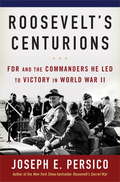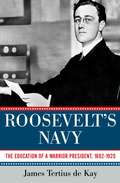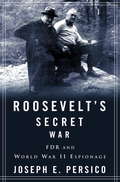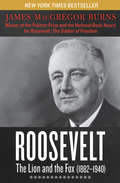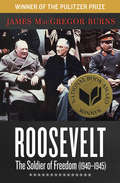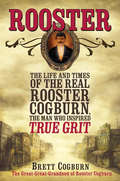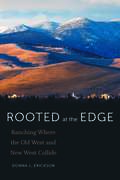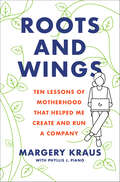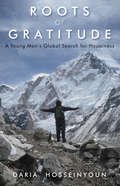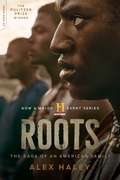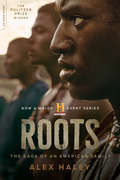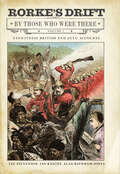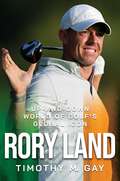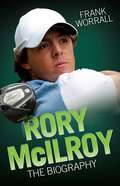- Table View
- List View
Roosevelt and the Holocaust: How FDR Saved the Jews and Brought Hope to a Nation
by Robert L. Beir Brian JosepherThe year was 1932. At age fourteen Robert Beir’s journey through life changed irrevocably when a classmate called him a “dirty Jew.” Suddenly Beir encountered the belligerent poison of anti-Semitism. The safe confines of his upbringing had been violated. The pain that he felt at that moment was far more hurtful than any blow. Its memory would last a lifetime.Beir’s experiences with anti-Semitism served as a microcosm for the anti-Semitism among the majority of Americans. That year, a politician named Franklin Delano Roosevelt ascended to the presidency. Over the next twelve years, he became a scion of optimism and carried a refreshing, unbridled confidence in a nation previously mired in fear and deeply depressed. His policies and ethics saved the capitalist system. His strong leadership and unwavering faith helped to defeat Hitler.The Jews of America revered President Roosevelt. To a young Robert Beir, Roosevelt was an American hero. In mid-life, however, Beir experienced a conflict. New research was questioning Roosevelt’s record regarding the Holocaust. He felt compelled to embark on a historian’s quest, asking only the toughest questions of his childhood hero, including: How much did President Roosevelt know about the Holocaust? What could Roosevelt have done? Why wasn’t there an urgent rescue effort?In answering these questions and others, Robert Beir has done a masterful job. This book is graphically written, well-researched, and provocative. The portrait depicted of a man he once thought to be morally incorruptible amidst a circumstance of moral bankruptcy is truly unforgettable.
Roosevelt the Explorer: T.R.'s Amazing Adventures as a Naturalist, Conservationist, and Explorer
by H. Paul JeffersJeffers' book chronicles Theodore Roosevelt's lifelong quests and expeditions—thrilling and often dangerous journeys that produced much important scientific research and took him across North America, South America, and Africa.
Roosevelt's Centurions: FDR and the Commanders He Led to Victory in World War II
by Joseph E. PersicoAll American presidents are commanders in chief by law. Few perform as such in practice. In Roosevelt's Centurions, distinguished historian Joseph E. Persico reveals how, during World War II, Franklin D. Roosevelt seized the levers of wartime power like no president since Abraham Lincoln during the Civil War. Declaring himself "Dr. Win-the-War," FDR assumed the role of strategist in chief, and, though surrounded by star-studded generals and admirals, he made clear who was running the war. FDR was a hands-on war leader, involving himself in everything from choosing bomber targets to planning naval convoys to the design of landing craft. Persico explores whether his strategic decisions, including his insistence on the Axis powers' unconditional surrender, helped end or may have prolonged the war. Taking us inside the Allied war councils, the author reveals how the president brokered strategy with contentious allies, particularly the iron-willed Winston Churchill; rallied morale on the home front; and handpicked a team of proud, sometimes prickly warriors who, he believed, could fight a global war. Persico's history offers indelible portraits of the outsize figures who roused the "sleeping giant" that defeated the Axis war machine: the dutiful yet independent-minded George C. Marshall, charged with rebuilding an army whose troops trained with broomsticks for rifles, eggs for hand grenades; Dwight Eisenhower, an unassuming Kansan elevated from obscurity to command of the greatest fighting force ever assembled; the vainglorious Douglas MacArthur; and the bizarre battlefield genius George S. Patton. Here too are less widely celebrated military leaders whose contributions were just as critical: the irascible, dictatorial navy chief, Ernest King; the acerbic army advisor in China, "Vinegar" Joe Stilwell; and Henry H. "Hap" Arnold, who zealously preached the gospel of modern air power. The Roosevelt who emerges from these pages is a wartime chess master guiding America's armed forces to a victory that was anything but foreordained. What are the qualities we look for in a commander in chief? In an era of renewed conflict, when Americans are again confronting the questions that FDR faced--about the nature and exercise of global power--Roosevelt's Centurions is a timely and revealing examination of what it takes to be a wartime leader in a freewheeling, complicated, and tumultuous democracy.Advance praise for Roosevelt's Centurions "[A] sweeping, top-down account of 1939-45 from the point of view of FDR, his cabinet and his leading generals and admirals. . . . Long wars demand long books, but these are 550 pages of lively prose by a good writer who knows his subject."--Kirkus Reviews "When I was a boy growing up in the South Bronx, my heroes were Roosevelt's centurions. As a soldier for thirty-five years, I made them my mentors and models. These men were heroes. They were fallible and occasionally vain, but we were certainly blessed to have such Americans leading the Greatest Generation during the world's greatest conflict. Of course, the greatest centurion of them all was FDR himself, who knew how to lead his commanders, stroke their egos, and get the best from them, yet never left any doubt as to who was commander in chief. Joe Persico, my valued collaborator on my memoirs, has brought his formidable talents to bear to bring the centurions to life. He is at the top of his game in this defining classic."--Colin L. Powell, General, U.S. Army (Retired).
Roosevelt's Navy
by James Tertius de KayFDR as never seen before: His formative years as Woodrow Wilson's Assistant Secretary of the Navy, evolving from political neophyte to visionary leader This is the story of a very different Franklin Delano Roosevelt from the one usually found in the history books. This is a much younger, untested FDR, a physically active, pre-polio FDR, as seen during his early years in Washington, learning the complexities of gaining and exercising power as Woodrow Wilson's ambitious Assistant Secretary of the Navy. He arrives in Washington as a somewhat shallow, inexperienced political neophyte possessed of little more than a famous name, but by the time he leaves the Navy eight years later he will have transformed himself into a seasoned professional, wise to the ways of power, a visionary ready and eager to take his place on the world stage. FDR's early years in Washington also include the most tumultuous period in his personal life, when, caught in a difficult marriage, he is forced to choose between his own personal happiness and his towering political ambitions. He must deal at close quarters with Congress, with the Administration, with the military, with big business. Lastly, but crucially, he confronts himself, learning something about his potential, his limitations, and his ambition. Such self-knowledge is perhaps the most valuable single gift that a leader of a democracy can hope for.
Roosevelt's Navy: The Education of a Warrior President, 1882-1920
by James Tertius de KayFDR as never seen before: His formative years as Woodrow Wilson's Assistant Secretary of the Navy, evolving from political neophyte to visionary leader. This is the story of a very different Franklin Delano Roosevelt from the one traditionally found in the history books. This is a much younger, untested, pre-polio FDR, learning the complexities of gaining and exercising power as Woodrow Wilson's ambitious Assistant Secretary of the Navy. He arrives in Washington as an inexperienced political amateur possessed of little more than a famous name, but by the time he leaves the Navy eight years later he will have transformed himself into a seasoned professional, wise to the ways of power, a visionary ready and eager to take his place on the world stage. FDR's early years in Washington also include the most tumultuous period in his personal life, when, caught in a difficult marriage, he is forced to choose between his own personal happiness and his political ambitions. He must deal at close quarters with Congress, with the Administration, and with the military. Lastly, but crucially, he confronts himself, learning something about his potential, his limitations, and his growing ambition to become president of the United States.
Roosevelt's Secret War: FDR and World War II Espionage
by Joseph E. PersicoDespite all that has already been written on Franklin Delano Roosevelt, Joseph Persico has uncovered a hitherto overlooked dimension of FDR's wartime leadership: his involvement in intelligence and espionage operations.Roosevelt's Secret War is crowded with remarkable revelations:-FDR wanted to bomb Tokyo before Pearl Harbor-A defector from Hitler's inner circle reported directly to the Oval Office-Roosevelt knew before any other world leader of Hitler's plan to invade Russia-Roosevelt and Churchill concealed a disaster costing hundreds of British soldiers' lives in order to protect Ultra, the British codebreaking secret-An unwitting Japanese diplomat provided the President with a direct pipeline into Hitler's councilsRoosevelt's Secret War also describes how much FDR had been told--before the Holocaust--about the coming fate of Europe's Jews. And Persico also provides a definitive answer to the perennial question Did FDR know in advance about the attack on Pearl Harbor?By temperament and character, no American president was better suited for secret warfare than FDR. He manipulated, compartmentalized, dissembled, and misled, demonstrating a spymaster's talent for intrigue. He once remarked, "I never let my right hand know what my left hand does." Not only did Roosevelt create America's first central intelligence agency, the OSS, under "Wild Bill" Donovan, but he ran spy rings directly from the Oval Office, enlisting well-placed socialite friends. FDR was also spied against. Roosevelt's Secret War presents evidence that the Soviet Union had a source inside the Roosevelt White House; that British agents fed FDR total fabrications to draw the United States into war; and that Roosevelt, by yielding to Churchill's demand that British scientists be allowed to work on the Manhattan Project, enabled the secrets of the bomb to be stolen. And these are only a few of the scores of revelations in this constantly surprising story of Roosevelt's hidden role in World War II.
Roosevelt: The Lion and the Fox (Roosevelt #1940)
by James MacGregor Burns&“A brilliant full-length portrait of Franklin Roosevelt the politician&”—the first in an award-winning two-volume biography (The Christian Science Monitor). Franklin Delano Roosevelt was the longest serving president in United States history, reshaping the country during the crises of the Great Depression and World War II. But before his ascension to the presidency, FDR laid the groundwork for his unprecedented run with decades of canny political maneuvering and steady consolidation of power. In this remarkable New York Times–bestselling biography, Pulitzer Prize–winning historian James MacGregor Burns traces FDR&’s rise and the peculiar blend of strength and cunning that made him such a uniquely transformative figure. Weaving together lively narrative and impressive scholarship, Burns reconstructs his youth and education at Groton and Harvard, his relationships with his cousins Theodore and Eleanor, his immersion in New York State politics, and his rise to national prominence, all the way through his first two terms as president, which saw the historic New Deal take hold and the drumbeats of World War II begin. Originally published in 1956, The Lion and the Fox was among the first studies of Roosevelt—and it remains a landmark record of his ambitions, talents, and flaws. Hailed by the New York Times as &“a sensitive, shrewd, and challenging book&” and by Newsweek as &“a case study unmatched in American political writings,&” Burns&’s stunning achievement is the life story of a fascinating political figure.
Roosevelt: The Soldier of Freedom (1940-1945) (Roosevelt #2)
by James MacGregor BurnsThe &“engrossing&” Pulitzer Prize and National Book Award–winning history of FDR&’s final years (Barbara Tuchman). The second entry in James Macgregor Burns&’s definitive two-volume biography of Franklin Delano Roosevelt begins with the president&’s precedent-breaking third term election in 1940, just as Americans were beginning to face the likelihood of war. Here, Burns examines Roosevelt&’s skillful wartime leadership as well as his vision for post-war peace. Hailed by William Shirer as &“the definitive book on Roosevelt in the war years,&” and by bestselling author Barbara Tuchman as &“engrossing, informative, endlessly readable,&” The Soldier of Freedom is a moving profile of a leader gifted with rare political talent in an era of extraordinary challenges, sacrifices, heroism, and hardship.
Rooster's Gold: A Novel
by A. Alan IsaacsRe-experience historical fact as it is woven into the fictional fabric of the Hawkins family with Xander Hawkins, an extremely wealthy man from Tennessee, who engages a New York lawyer to create a Trust Fund to provide for the continuation of his dream: the encouragement, education, and care of orphans.A. Alan Isaacs invites readers to sit in Xander&’s study alongside the lawyer as he listens to stories about how the Hawkins family discovered a love for orphans and an unimaginable treasure! Over several days, the lawyer learns how more than 200 years of &‘Journaling&’ from Xander&’s ancestors continues to influence his approach to life. Along the way, readers can snap pictures of QR Codes embedded throughout Rooster&’s Gold to effortlessly connect the written word to an internet-based resource. Readers can also fact-check Xander&’s stories as his relatives encounter several of history&’s heroes, such as Davy Crockett, Theodore Roosevelt and his Rough Riders, and many more!After returning from the Spanish-American war, Rooster&’s son learns that orphaned and abandoned children are being put on trains in New York City and &‘whistle-stopped&’ across the United States to live and work on farms to produce crops for the country&’s exploding population. Witness how the stories of these Orphan Train Children profoundly impact the Hawkins&’ family—and the New York lawyer.
Rooster: The Life and Times of the Real Rooster Cogburn, the Man Who Inspired True Grit
by Brett CogburnThe True Story Behind True GritImmortalized in the classic novel and films, the real "Rooster" Cogburn was as bold, brash, and bigger-than-life as the American West itself. Now, in this page-turning account, Cogburn's great-great-grandson reveals the truth behind the fiction--and the man behind the myth. . .He was born in 1866 in Fancy Hill, Arkansas, the descendant of pioneers and moonshiners. Six foot three, dark eyed, and a dead shot with a rifle, Franklin "Rooster" Cogburn was as hard as the rocky mountain ground his family settled. The only authority the Cogburn clan recognized was God and a gun. And though he never packed a badge, Rooster meted out his own brand of justice--taking on a posse of U.S. deputy marshals in a blazing showdown of gunfire and blood. Now a wanted man, with a $500 reward on his head, Rooster would ultimately have to defend himself before a hanging judge. Proud, stubborn, fearless, and ornery to the bitter end. A fascinating portrait of a true American icon, Rooster shows us the making of a legend--fashioned by Arkansas newspaperman Charles Portis with bits and pieces of historical figures, including Deputy Reuben M. Fry, one-eyed Deputy Marshal Cal Whitson, Joseph Peppers (Lucky Ned), Joseph Spurling (Mattie Ross's grandfather) and bank robber Frank Chaney (scar-faced Tom Chaney.) Behind it all stood a man named "Rooster," with two good eyes and a tale all his own. With never-before-seen photosSome folks are just born to tell tall tales. Brett Cogburn was reared in Texas and the mountains of Southeastern Oklahoma. He was fortunate enough for many years to make his living from the back of a horse, where on cold mornings cowboys still straddled frisky broncs and dragged calves to the branding fire on the end of a rope from their saddlehorns. Growing up around ranches, livestock auctions, and backwoods hunting camps filled Brett's head with stories, and he never forgot a one. In his own words: "My grandfather taught me to ride a bucking horse, my mother gave me a love of reading, and my father taught me how to hunt my own meat and shoot straight. Cowboys are just as wild as they ever were, and I've been damn lucky to have known more than a few." The West is still teaching him how to write. His first novel, Panhandle, will be published in November 2012. Brett Cogburn lives in Oklahoma with his family.
Rooted at the Edge: Ranching Where the Old West and New West Collide
by Donna L. EricksonRooted at the Edge paints a portrait of a ranching community in a threatened landscape steeped in history, conflict, and beauty. In this narrative nonfiction work, Donna L. Erickson explores the hilly skirt of ground at the northern boundary of Missoula, Montana, separating the town from the wilderness beyond. The North Hills region represents the critical—and often highly personal—issues at play at the edge of many western towns. The urban-rural fringe is both valuable and vulnerable. Across the West rural lifestyles are increasingly compromised by suburbanization, economic hardship, and family dynamics; a way of life and a way of work are vanishing. Ranchland may be simultaneously cherished by a family for the life its members have made there and coveted by urban neighbors for open space. Community residents may love a place for its scenery and wildlife habitat while others wish it converted to a commercial parking lot. Complex ecological relationships can be bulldozed in a single afternoon. And the threats of climate change and shifting populations compromise the edge even more. In the tension between love and loss, Erickson wrote this story of a landscape&’s soft contours, piney ridges, shady draws, and grassy slopes, and its potential disappearance under an expanding city. Rooted at the Edge conveys, in a way that statistics cannot, what&’s at stake when ranches at the urban fringe are threatened.
Rooted in the Earth, Rooted in the Sky: Hildegard of Bingen and Premodern Medicine
by Victoria SweetRooted in the Earth, Rooted in the Sky is a detailed study of the medicine of Hildegard of Bingen, a medieval mystic, theologian and composer, who also wrote a practical medical text. Although there has been an explosion of interest in Hildegard's music, theology, illuminations and medicine in the last two decades, this is the first book to use her remarkable text to revise not only our conception of Hildegard but also of premodern medicine itself. It does so by contextualizing her work with primary and secondary historical sources, unedited manuscripts, anthropological and archeological evidence and linguistic analyses. Its surprising conclusion is that the premodern body was more like a plant than a machine or a computer program, and the physician more like a gardener than a mechanic or a computer programmer.
Rootlines: A Memoir
by Rikki WestRikki and her sister, Linda, fell out with one another four months ago. They are not speaking when Linda emails that she has lethal abdominal tumors, that her only hope of survival is a total bone marrow replacement. Linda claims Rikki is too old to donate, and explains there’s only a slight chance she is a good match anyway—but Rikki refuses to accept that. Despite the wounding between them, Linda’s email ignites a wild aspiration in her sister: she will become the perfect donor, the perfect match, with the healthiest, most vigorous cells possible. She rises with intent to heal herself, her sister, and their rootlines, the patterns formed in their family of origin that have quietly shaped their lives. Rikki walks through the science while confronting dogma that limits how mind can transform body. She builds herself into a stem cell factory using Muay Thai kickboxing and vegetarian nutrition. Working through childhood wounds and mental limits with meditation and yoga, she finds her own power, as well as ways to show up for Linda and walk with her from the edge of death to a new life. Together, the two sisters beat the lymphoma—and, as they rediscover the intimacy and love of their innocent childhood, heal the intertwined roots of their family pain.
Roots Schmoots: Journeys Among Jews
by Howard JacobsonWherever there is a Jew there is a journey; for a Jew to go travelling in search of his Jewishness is therefore doubly Jewish. When fast-breaking political events forced British novelist Jacobson (Peeping Tom) to put off a trip to Lithuania planned as a search for his Jewish roots, he accepted an offer from the BBC to visit Jewish communities around the globe instead. This informed and witty account of his experiences deals with the wide variety of contemporary Jewish life, as well as with how Jacobson's observations affected his own concept of what it means to be a Jew. Riding an emotional roller coaster, he witnessed the hostility between Jews and African Americans in New York City, attended services in a gay synagogue in California and found his basic cynicism about religion reinforced after he spent time with Orthodox Jews in Israel, although his spirits were lifted by a visit to an idealistic, tolerant Israeli kibbutz. His journey concluded with the postponed trip to Lithuania, where the author found virulent anti-Semitism. The book has been adapted for a forthcoming BBC/PBS documentary.
Roots and Rhythm: A Life in Music
by Charlie PeacockA beautifully crafted memoir unveiling the ancestral, musical, and spiritual roots of Grammy Award-winning music producer Charlie Peacock. In this artful memoir, Grammy Award–winning music producer Charlie Peacock flexes his literary chops and gives readers the gritty backstage stories they crave: biographical anecdotes, geeky trivia, and how the hits were written and recorded (from jazz to rock and pop). Threaded throughout is Peacock&’s unique ancestral and spiritual story—the roots. Like Coltrane, Dylan, and Bono before him, Peacock reveals a Christ-affection while refusing genres too small for his music. Peacock, the great-grandson of a Louisiana fiddler, is an American musical polymath. He&’s been the young jazz musician sitting at the feet of trumpeter Eddie Henderson and pianist Herbie Hancock; the singer-songwriter plucked from the Northern California punk/pop underground by legendary impresarios Bill Graham and Chris Blackwell; a pioneering, innovative contributor to the nascent rise of gospel rock in the 1980s; and the genre-busting producer behind such diverse artists as Al Green, Ladysmith Black Mambazo, Chris Cornell, Audio Adrenaline, The Civil Wars, Switchfoot, Turtle Island Quartet, and John Patitucci.Roots and Rhythm includes Peacock&’s seminal NorCal days, the story of indie labels Exit and re:think, his first decade as a Nashville producer (1989–1999), and his essential role in the 21st-century folk/Americana boom (The Civil Wars, Holly Williams, The Lone Bellow). While his exploits and achievements grace the book (including the story of Amy Grant&’s &“Every Heartbeat&” and the evergreen &“In the Light&”), Peacock is hardly the only character. Instead, he writes as a Joan Didion-style essayist, weaving together a quintessential American story. Beat poet Gary Snyder, evangelist Billy Graham, producer T Bone Burnett, saxophonist Wayne Shorter, and writers Wendell Berry and Isabel Wilkerson all appear in this sweeping tale where ancestry, migration, teenage love, Jesus, and Miles Davis collide. The book is an invitation to all, including aspiring musicians: embrace the roots and rhythm of our own lives, letting the music and God&’s insistent love lead us to gratitude and wonder.
Roots and Wings: Ten Lessons of Motherhood that Helped Me Create and Run a Company
by Phyllis J. Piano Margery KrausA child of immigrants, Margery Kraus knew the value of hard work from an early age. Graduating from college before she had finished high school, she learned to be a risk taker. As a young wife and mother coming of age in the 1960s, she faced plenty of people who told her, “You can’t do that.” But in the end, she did: she founded APCO Worldwide, a global consulting firm headquartered in Washington, DC, specializing in public affairs, communication, and business consulting for major multinationals. Under her leadership, the company grew from nothing to almost $150 million in revenues. In Roots And Wings, Kraus shares the ten lessons she learned from motherhood and leadership that guided her along the way—an inspiration to all seeking to overcome obstacles, achieve career and personal success, and do the right thing.
Roots of Gratitude
by Daria HosseinyounIf you had it all, what would you do? At the age of 20, Daria felt he had everything and nothing. To outside observers, he had it all: a loving family, a beautiful girlfriend, materials riches, and a family business waiting for him to assume leadership, but there was a gnawing feeling that something was missing. When Daria's friend dies at the age of 21, he is shaken at the roots. Witnessing death for the first time, he questions every aspect of life including the origins of suffering and happiness. He wonders why he is following the herd in a life-consuming race towards emptiness. Hungry for meaning, he leaves everything he's ever known to expose himself to the reality of the world through his own experience. His journey takes him on an expedition through the countryside of Mongolia where he learns of generosity, surfing the coasts of Bali, experiences the essence of martial arts from Aikido masters and back-country snowboarding in Japan. He ventures through India, learning yoga and meditation, and finds a prominent monk in Nepal who "freezes" him, shifting his understanding of the world around him. With his new found knowledge, he sets out on a 12-day trek to witness the colossal peaks of the Everest region, where his experience is nothing short of the divine. Daria's path leads him to snakes and stitches, avalanches and wolves, death and rebirth in order to return to society and impart one message: a new-found understanding. Daria makes no claims to be a saint or a revolutionary. He faces the same dilemmas that many of us face on a daily basis and through his mistakes gains a better understanding of who he is and how he wants to live his life. Roots of Gratitude presents an inspirational and captivating journey of a young man's search for his true self. By sharing his experiences with readers - his struggles between following his dreams and societal expectations, and his magnificent spiritual awakening - he imparts courage to follow our hearts and to experience the world for ourselves, so that we may all find a way to our true (and grateful) selves.
Roots-The Enhanced Edition: The Saga of an American Family
by Alex HaleyRoots is a groundbreaking story of history and family that spanned continents and touched generations. One of the most important books and television series ever to appear, Roots galvanized the nation and created an extraordinary political, racial, social and cultural dialogue that hadn’t been seen since the publication of Uncle Tom’s Cabin. The book sold over one million copies in the first year, and the miniseries was watched by an astonishing 130 million people. It also won both the Pulitzer Prize and the National Book Award. Roots opened up the minds of Americans of all colors and faiths to one of the darkest and most painful parts of America’s past, and we continue to feel its reverberations today.
Roots-Thirtieth Anniversary Edition
by Alex HaleyOne of the most important books and television series ever to appear, Roots, galvanized the nation, and created an extraordinary political, racial, social and cultural dialogue that hadn’t been seen since the publication of Uncle Tom’s Cabin. The book sold over one million copies in the first year, and the miniseries was watched by an astonishing 130 million people. It also won both the Pulitzer Prize and the National Book Award. Roots opened up the minds of Americans of all colors and faiths to one of the darkest and most painful parts of America’s past. Over the years, both Roots and Alex Haley have attracted controversy, which comes with the territory for trailblazing, iconic books, particularly on the topic of race. Some of the criticism results from whether Roots is fact or fiction and whether Alex Haley confused these two issues, a subject he addresses directly in the book. There is also the fact that Haley was sued for plagiarism when it was discovered that several dozen paragraphs in Roots were taken directly from a novel, The African, by Harold Courlander, who ultimately received a substantial financial settlement at the end of the case. But none of the controversy affects the basic issue. Roots fostered a remarkable dialogue about not just the past, but the then present day 1970s and how America had fared since the days portrayed in Roots. Vanguard Press feels that it is important to publish Roots: The 30th Anniversary Edition to remind the generation that originally read it that there are issues that still need to be discussed and debated, and to introduce to a new and younger generation, a book that will help them understand, perhaps for the first time, the reality of what took place during the time of Roots.
Roots: The Saga Of An American Family
by Alex HaleyOne of the most important books and television series ever to appear, Roots, galvanized the nation, and created an extraordinary political, racial, social and cultural dialogue that hadn't been seen since the publication of Uncle Tom's Cabin. The book sold over one million copies in the first year, and the miniseries was watched by an astonishing 130 million people. It also won both the Pulitzer Prize and the National Book Award. Roots opened up the minds of Americans of all colors and faiths to one of the darkest and most painful parts of America's past. Over the years, both Roots and Alex Haley have attracted controversy, which comes with the territory for trailblazing, iconic books, particularly on the topic of race. Some of the criticism results from whether Roots is fact or fiction and whether Alex Haley confused these two issues, a subject he addresses directly in the book. There is also the fact that Haley was sued for plagiarism when it was discovered that several dozen paragraphs in Roots were taken directly from a novel, The African, by Harold Courlander, who ultimately received a substantial financial settlement at the end of the case. But none of the controversy affects the basic issue. Roots fostered a remarkable dialogue about not just the past, but the then present day 1970s and how America had fared since the days portrayed in Roots.
Roots: The Saga of an American Family (Modern Classics Ser.)
by Alex HaleyA new eight-hour event series based on Roots will be simulcast on the History Channel, Lifetime, and A&E over four consecutive nights beginning Memorial Day, May 30, 2016 When Roots was first published forty years ago, the book electrified the nation: it received a Pulitzer Prize and was a #1 New York Times bestseller for 22 weeks. The celebrated miniseries that followed a year later was a coast-to-coast event-over 130 million Americans watched some or all of the broadcast. In the four decades since then, the story of the young African slave Kunta Kinte and his descendants has lost none of its power to enthrall and provoke. Now, Roots once again bursts onto the national scene, and at a time when the race conversation has never been more charged. It is a book for the legions of earlier readers to revisit and for a new generation to discover. To quote from the introduction by Michael Eric Dyson: "Alex Haley's Roots is unquestionably one of the nation's seminal texts. It affected events far beyond its pages and was a literary North Star.... Each generation must make up its own mind about how it will navigate the treacherous waters of our nation's racial sin. And each generation must overcome our social ills through greater knowledge and decisive action. Roots is a stirring reminder that we can achieve these goals only if we look history squarely in the face.” The star- studded cast in this new event series includes Academy Award-winners Forest Whitaker and Anna Paquin, Laurence Fishburne, Jonathan Rhys Meyers, Derek Luke, Grammy Award-winner Tip "T.I.” Harris, and Mekhi Phifer. Questlove of The Roots is the executive music producer for the miniseries's stirring soundtrack.
Rope Burns
by Robert ScottThe true crime story of a killer couple from California, their gruesome torture chamber on wheels, and the terror they left in their wake.The true story of one of the most notorious crime couples in recent American history is told. Michelle Michaud and James Daveggio forged a perverse alliance in late 1997. After customizing Michaud's minivan into a mobile torture chamber, the pair hit the road and began a nightmare spree of incest, kidnapping, rape, torture, and murder.Sixteen Pages of Shocking Photos!Michaud and Daveggio&’s case was featured on Oxygen&’s Snapped: Killer Couples.
Rorke's Drift By Those Who Were There, Volume 1: Eyewitness British and Zulu Accounts
by Ian Knight Lee Stevenson Alan Baynham-Jones“The great host came steadily on, spreading out spreading out - spreading out till they seemed like a giant pair of nut-crackers opening round the little nut of Rorke’s Drift.” – Surgeon Major James Henry Reynolds V.C., Army Medical Department On 22 January 1879, during the final hour of the Battle of iSandlwana – one of the greatest disasters ever to befall British troops during the Victorian era – a very different story was about to unfold a few miles away at the mission station of Rorke’s Drift. When a Zulu force of more than 3,000 warriors turned their attention to the small outpost, defended by around 150 British and Imperial troops, the odds of the British surviving were staggeringly low. The British victory that ensued, therefore, would go down as one of the most heroic actions of all time, and has enraptured military history enthusiasts for decades. Featuring a wide range of first-hand accounts and testimonies from those present during the Battle of Rorke’s Drift, Rorke’s Drift By Those Who Were There is a remarkable work of Anglo-Zulu military history by those who know the topic best, Lee Stevenson and Ian Knight. This updated edition of the classic work of the same name includes even more first-person accounts from the combatants on both the British and Zulu sides. Providing personal, microscopic accounts of events, while at the same time presenting a clear overview of the battle in its entirety, readers will gain an impressive, unique breadth of knowledge about one of the most awe-inspiring battles in British history.
Rory Land: The Up-and-Down World of Golf's Global Icon
by Timothy M. GayRORY LAND is the unabashed story of Rory McIlroy, golf&’s most compelling icon, the caring but conflicted soul from a troubled Irish homeland with a swing that borders on the immaculate.Timothy M. Gay writes that four-time major champion Rory McIlroy is &“golf&’s ageless Opie Taylor,&” a freckled superstar whose boyish charm transcends national boundaries and enlivens the game. His seemingly effortless swing is so powerful that Tiger Woods is teaching his own son to mimic Rory&’s action. But a charismatic persona and a pretty swing don&’t necessarily translate into winning major championships. Over the past decade, Rory has had his heart ripped out as he&’s failed to win another major and fallen short of achieving the career Grand Slam. He&’s also become a lightning rod, getting into a profanity-laced smackdown at the &’23 Ryder Cup and, after his betrayal by PGA Tour brass, causing head-scratching confusion by going from an impassioned opponent of a deal with the Saudi-backed LIV Golf to an outspoken proponent. His backtrack on LIV fits a disquieting pattern, Gay reveals, of Rory&’s propensity to flip-flop on key principles and people. McIlroy is from Northern Ireland, a geopolitical anomaly where religion and patriotism have been used as bloody cudgels for much of the past century. Both sides of his family were battered by the North&’s sectarian Troubles—ugly realities that McIlroy has been loath to acknowledge. Rory is, Gay believes, a man essentially without a country, which might explain why he&’s become so obsessed with the Ryder Cup. Gay argues that McIlroy has, in effect, invented his own fiefdom, which the author has dubbed &“RORY LAND.&” RORY LAND tells the up-and-down saga of a compassionate and kind-hearted superstar living in a world where &“money has no conscience.&”
Rory Mcilroy: The Biography
by Frank WorrallHis amazing amateur career saw him conquer Ireland and Europe before topping the World Amateur rakings in 2007. But he really came to prominence with his superb opening three-under-par 68 in the 2007 Open Championship at Carnoustie. He went on to accept the Silver Medal as leading amateur.Despite high expectations, Rory keeps a cool head on his young shoulders and lets his golf do the talking. In 2008 he entered the elite of the top 100 in the Official World Golf Rankings and his maiden victory came in the 2009 Dubai Desert Classic where he endured a nail-biting final hole.His final breakthrough came when in June 2011 he won his first major, the US Open at Congressional Country Club in Maryland, USA. Rory finished an amazing total of sixteen under par to seal his place among the golfing greats. This is the fascinating story of one of golf's most exciting young talents.


